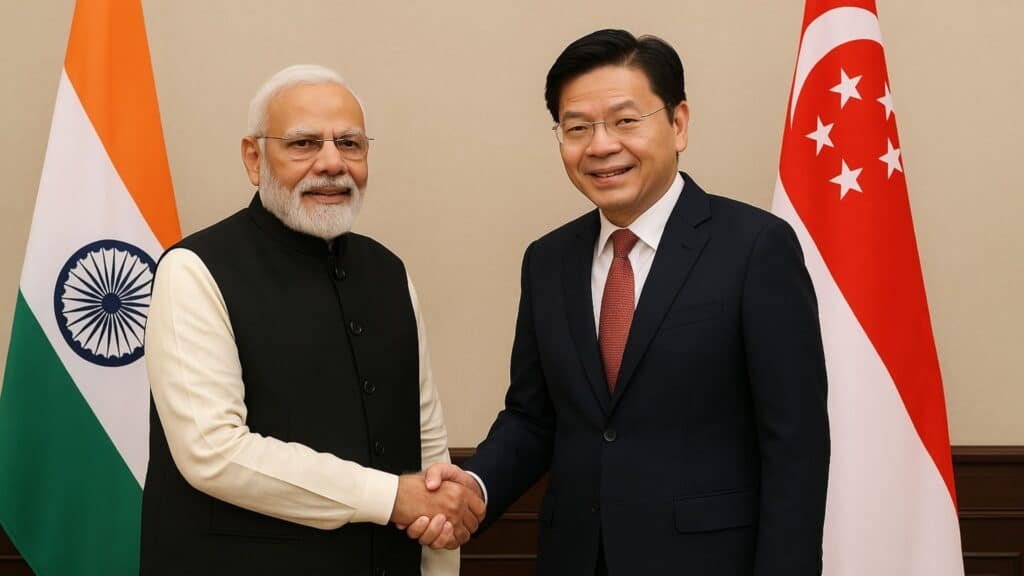When Singapore’s Prime Minister Lawrence Wong met Prime Minister Narendra Modi, the headlines focused on trade and technology. But buried in the joint statement was something far more strategic: Singapore openly acknowledged India’s interest in joining the Malacca Straits Patrol. That’s not a casual nod. It’s a signal that India’s role in securing one of the world’s busiest maritime highways is now on the table.
The Malacca Strait isn’t just another shipping route. It’s the narrow passage through which nearly half of global seaborne trade and most of Asia’s imported oil moves. Whoever helps guard it has a say in how global commerce flows. And now, India is positioning itself as one of those guardians.
Let’s break down why this matters, what India brings to the table, and how this could change the balance of power in the Indo-Pacific.
The Geography That Shapes the Game

If you look at a map, the Strait of Malacca connects the Indian Ocean with the South China Sea and onward to the Pacific. On its western end lies the Andaman Sea, where India’s Andaman and Nicobar Islands sit like natural sentinels. On the eastern end, Singapore and Malaysia keep watch over the choke point leading into the South China Sea.
This geography creates a paradox. The strait is narrow, at points only about 1.5 nautical miles wide, but it carries immense global weight. Every day, supertankers, container vessels, and cargo ships pass through in a dense stream. Any disruption here, be it piracy, terrorism, accidents, or military blockades, would ripple across the global economy.
For India, this is not an abstract risk. The country’s trade and energy supplies depend heavily on these waters. The Andaman and Nicobar Islands, just a short hop from the strait, make India not just a stakeholder but a natural frontline player.
How the Malacca Straits Patrol Works
The Malacca Straits Patrol (MSP) isn’t one navy patrolling solo. It’s a coordinated effort that started in 2004 when Indonesia, Malaysia, and Singapore came together to keep the strait safe. Thailand joined later.
The MSP has three main parts:
- Sea Patrols (MSSP): Joint naval operations where ships from each country patrol designated sectors, sometimes overlapping to ensure constant presence.
- Eyes-in-the-Sky (EiS): Aerial surveillance missions with mixed crews from the member countries, watching for suspicious vessels or activities.
- Intelligence Exchange Group (IEG): A real-time network for sharing information, so that a suspicious boat spotted by one navy can be tracked across borders without delays.
This setup has been remarkably effective. Piracy, once rampant in the Malacca Strait, has dropped sharply since the patrols began. Still, new threats from smuggling to potential gray-zone tactics by state actors keep the pressure on.
Why India Wants In
Here’s the thing: India isn’t asking to join out of charity or symbolic presence. There are concrete reasons.
- Strategic Proximity: With the Andaman and Nicobar Islands so close, India is already in the neighborhood. Its naval and air assets regularly operate nearby. Leaving India out of the MSP feels like ignoring a natural partner.
- Energy Security: India imports around 80 percent of its oil, much of it sailing through the Malacca Strait. Any disruption would hit its economy hard. Having a role in securing the strait means protecting its lifeline.
- Countering China’s Moves: China calls the Malacca Strait its “Malacca Dilemma” because it relies heavily on the route for energy imports. Beijing has responded by building alternate pipelines and ports in Myanmar and Pakistan. By joining the MSP, India indirectly balances China’s influence in the region.
- Expanding Maritime Role: India has pitched itself as a net security provider in the Indian Ocean. Participating in MSP would back that claim with tangible action.
Singapore’s Calculated Support
Singapore’s support is not just a friendly gesture. For Singapore, the strait is existential. Its economy and security hinge on keeping the waters safe. Inviting India into the fold strengthens the patrols without diluting Singapore’s leadership role.
It also reflects growing trust. Defence cooperation between India and Singapore has deepened steadily from naval exercises to logistics agreements. By supporting India’s MSP participation, Singapore is signaling to others in the region, especially Indonesia and Malaysia, that India deserves a seat at the table.
The Diplomatic Balancing Act
But not everyone may cheer. Malaysia and Indonesia have historically been cautious about outside involvement in the strait. They view it as their sovereign backyard. The MSP itself was born out of their determination to keep control local, resisting early proposals for broader international patrols.
For India to join, there will have to be careful diplomacy. That’s why P. Kumaran, India’s Secretary (East), spoke of “coordination” and “synergy” rather than formal membership. The language signals flexibility, India may not insist on equal status right away but could start with joint operations, intelligence sharing, or observer roles.
The Bigger Indo-Pacific Picture
What this really means is that India’s maritime strategy is evolving. The Indo-Pacific isn’t just a buzzword. It’s a lived reality where trade routes, alliances, and naval power intersect.
India has already joined initiatives like the Quad with the US, Japan, and Australia, focusing on maritime security. It has launched the Indo-Pacific Oceans Initiative (IPOI) to promote cooperation on everything from disaster relief to connectivity. Adding the MSP to its portfolio strengthens India’s credibility.
For regional states, India’s participation adds balance. The MSP remains Southeast Asia-led, but with India’s backing, it becomes harder for any single external power, read China, to dominate the conversation.
Challenges on the Horizon
Of course, nothing is straightforward. India’s entry into the MSP will face hurdles.
- Consensus Among Members: Indonesia and Malaysia may hesitate, worried about sovereignty.
- Operational Integration: Coordinating patrols across different navies requires trust and standard protocols. Adding a fifth player complicates logistics.
- Political Sensitivities: China will view India’s involvement with suspicion, possibly framing it as containment. That could test regional states’ balancing acts.
Yet the potential benefits, enhanced security, better coordination, reduced piracy, and stronger deterrence, make it likely that the conversation will move forward.
India’s Next Moves
So, what happens next? India will likely:
- Expand naval exercises with current MSP members to build trust.
- Use the Andaman and Nicobar Command as a staging ground for joint operations.
- Offer technology and intelligence capabilities, from drones to satellite surveillance.
- Engage in quiet diplomacy with Malaysia and Indonesia to address sovereignty concerns.
This isn’t a sprint. It’s a gradual process where India first contributes informally before being fully woven into the MSP framework.Why the Malacca Strait Will Stay in Focus
The Malacca Strait has been at the heart of global trade for centuries. From spice traders to oil tankers, its waters have shaped economies and empires. In today’s world, the stakes are higher than ever.
Energy security, supply chain resilience, and geopolitical competition all converge here. That’s why India’s bid to join the patrols isn’t just a footnote. It’s a move with long-term consequences, for India, for Southeast Asia, and for the wider Indo-Pacific.
Wrapping It Up
India’s push to join the Malacca Straits Patrol, backed by Singapore, marks an important turning point. It reflects India’s growing maritime ambitions, the realities of its geography, and the shared responsibility of keeping one of the world’s most important trade arteries secure.
The path won’t be smooth. Diplomacy will matter as much as naval power. But if successful, India’s role in the MSP could reshape regional security and give it a stronger hand in the Indo-Pacific.
At its core, this is about more than patrols. It’s about who gets to shape the rules of the sea in Asia’s most vital waters.
Read More: Explainer | Why Putin Won’t Let Go of Donbas, and Why Zelenskyy Can’t Give It Up




